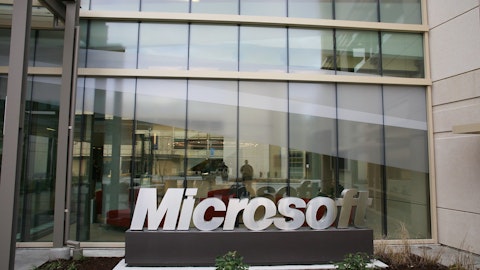We recently compiled a list of the 11 Biggest Lithium Stocks to Buy Right Now. In this article, we are going to take a look at where EnerSys (NYSE:ENS) stands against the other lithium stocks.
Despite challenges like pricing and demand headwinds in 2023, the U.S. and Canadian lithium sectors are set to make progress in 2024, with several construction projects potentially starting to boost domestic lithium supply. According to an S&P Global report, while the lithium market has seen slow activity and falling prices, especially in Asia, long-term demand fundamentals remain strong due to the global transition toward electric vehicles (EVs) and energy storage.
Even though lithium prices dropped in 2023 after reaching record highs in 2022, the long-term outlook for the EV market remains promising. According to the report, EV sales are expected to reach 30.81 million units by 2027, and lithium prices are expected to stabilize between $20,000 and $25,000 per metric ton in the coming years. Despite the industry’s cyclical nature, current pricing remains strong enough to attract investment, especially with regulatory support driving the EV transition in countries like Canada.
According to industry experts like Rahul Sen Sharma, setbacks are common in large-scale industry transformations, and the lithium market is no exception. Jean-François Béland of Ressources Québec compared lithium’s importance in the 21st century to that of coal and oil in previous eras, which shows the crucial role of lithium in electrifying transportation.
Long-Term Outlook for Lithium
According to the International Energy Agency (IEA), lithium demand is projected to rise tenfold in the Net Zero Emissions scenario and could reach 1,700 kilotonnes (kt). The market is further supported by developments in battery storage, with lithium demand for storage expected to grow more than ten times by 2050.
While alternative technologies like sodium-ion and vanadium flow batteries may slightly impact lithium demand, the metal’s role in battery production remains dominant. Moreover, solid-state batteries could create a new demand for lithium metal by 2040.
On the supply side, lithium production has significantly increased, with current global output at 190 kt, mainly from Australia and Latin American countries like Chile and Argentina. By 2030, global supply is projected to rise to 450 kt in a base scenario, but further investments will be necessary to meet future demand, especially in meeting climate goals.
Dealing With Supply Shortages
According to Benchmark Mineral Intelligence, lithium-ion battery demand is projected to nearly quadruple by 2030, reaching 3.9 terawatt-hours. The market intelligence firm forecasts lithium surplus till 2029, but despite that, the firm says that the supply of environmentally and socially responsible lithium is currently insufficient to meet demand.
Sustainably sourced lithium is not enough to meet growing demand. By 2026, only 45% of lithium demand is expected to be met by recycled or sustainably mined lithium, dropping to 35% by 2030.
In light of that, Direct Lithium Extraction (DLE), is gaining traction as a more efficient and sustainable alternative. According to BloombergNEF, DLE is expected to contribute significantly to lithium supply by 2030 and could potentially rival the output of evaporative methods, if commercialized successfully.
Lithium can be sourced from hard rock deposits like spodumene and lepidolite, as well as from brine. The main challenge with the evaporative method is its slow processing time, taking up to 18 months to extract lithium. On the other hand, DLE can reduce this timeframe to two weeks while using land and water more efficiently. Despite a decline in lithium prices, investments in DLE continue, as it offers faster and more sustainable extraction from brine sources.
According to Benchmark, DLE is a promising technology that could help prevent future lithium supply shortages by efficiently extracting lithium from brines. It is expected to contribute 14% of the global lithium supply by 2035, especially from brines, geothermal, and oil fields. However, DLE faces challenges such as high costs, scalability issues, and inflation, which have increased project expenses.
DLE offers higher recovery rates (80-90%) compared to traditional evaporation methods (20-50%). Major oil companies like Exxon are investing in DLE due to its similarities with oil extraction. Despite its potential, DLE alone won’t solve the lithium market’s structural deficits in the short term.
Our Methodology
For this article, we scoured through ETFs and stock screeners to find the 25 biggest players in the lithium and lithium battery industry that are listed on the NYSE or NASDAQ. We then narrowed down our list to 11 stocks most widely held by institutional investors. We listed the stocks in ascending order of their hedge fund sentiment which was taken from Insider Monkey’s database of over 900 elite hedge funds.
Why are we interested in the stocks that hedge funds pile into? The reason is simple: our research has shown that we can outperform the market by imitating the top stock picks of the best hedge funds. Our quarterly newsletter’s strategy selects 14 small-cap and large-cap stocks every quarter and has returned 275% since May 2014, beating its benchmark by 150 percentage points (see more details here).

A close up view of an energy efficient system housed in a specialized cabinet.
EnerSys (NYSE:ENS)
Market Capitalization as of September 5: $3.876 billion
Number of Hedge Fund Holders: 30
One of the biggest lithium stocks, EnerSys (NYSE:ENS) is a leading global provider of energy storage solutions, serving a wide range of industrial applications with its diverse portfolio. The company’s expertise is across manufacturing and distributing energy systems, motive power batteries, specialty batteries, battery chargers, and various power equipment.
It is particularly known for its contributions to telecommunications, broadband, utility industries, and critical backup power systems. A significant part of the company’s success comes from its comprehensive energy solutions, which include everything from power conversion to energy storage systems. The company’s NexSys iON lithium-ion batteries are designed for demanding industrial uses, such as material handling, and come with a sophisticated Battery Management System (BMS) that enhances safety and performance.
Meanwhile, its PowerSafe iON batteries provide crucial backup power for broadband networks, with the PowerSafe iON 36-1800 model offering up to 1800 Watts of power to sustain network operations for up to 72 hours during power outages.
The company’s acquisition of NorthStar reinforced its leadership in the premium Thin Plate Pure Lead battery market as it expanded its reach across all its business segments. The company is also making significant strides in expanding its production capabilities.
It plans to build a 4-GWh lithium-ion cell manufacturing facility in Greenville, South Carolina, with construction set to begin in early 2025 and operations anticipated to start in late 2027. The new plant will focus on producing a variety of lithium-ion cells for commercial, industrial, and defense applications, which will reduce its dependency on international suppliers.
Additionally, the company partnered with Verkor in 2023, a European battery technology firm, to explore the development of a lithium-ion battery factory in the U.S. The collaboration aims to improve both companies’ growth prospects and support the transition to clean energy with cutting-edge battery technology.
The company’s batteries have a proven track record in demanding environments, including space missions. As of February 2022, its batteries have accumulated an impressive 6.8 billion operational cell hours in space, powering missions to Earth, Mars, Venus, and even NASA’s Parker Solar Probe.
In its recent fiscal Q1 2025 earnings report, EnerSys (NYSE:ENS) delivered a non-GAAP EPS of $1.98, which surpassed expectations. It showed strong financial performance with $853 million in revenue.
On August 27, Roth MKM Chip Moore started coverage of the stock with a Buy rating and a $120 price target. The analyst cited the company’s strong position in addressing evolving power challenges and its innovative responses to trends like electrification and automation. The positive outlook highlights its potential for continued growth and its role as a key player in the energy transition.
According to our database, 30 hedge funds held stakes in EnerSys (NYSE:ENS) in the second quarter, with positions worth $430.571 million. With a position valued at $94.022 million, AQR Capital Management is the largest shareholder of the company, as of June 30.
Overall ENS ranks 3rd on our list of the best lithium stocks to buy. While we acknowledge the potential of ENS as an investment, our conviction lies in the belief that AI stocks hold greater promise for delivering higher returns and doing so within a shorter timeframe. If you are looking for an AI stock that is more promising than ENS but that trades at less than 5 times its earnings, check out our report about the cheapest AI stock.
Read Next: $30 Trillion Opportunity: 15 Best Humanoid Robot Stocks to Buy According to Morgan Stanley and Jim Cramer Says NVIDIA ‘Has Become A Wasteland’.
Disclosure: None. This article is originally published at Insider Monkey.





